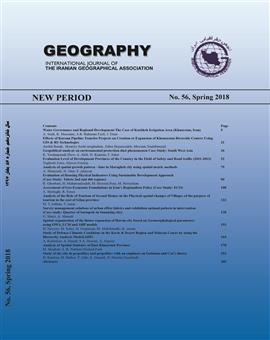Analysis of Spatial Statistics of Dust Khuzestan Province
Subject Areas :Ahmad Reza Nakhaie Nezhad Fard 1 , Marzieh Mogholi 2
1 -
2 -
Keywords: Dust Khuzestan Province Hot and Cold Spots Moran Structure Spatial Autocorrelation,
Abstract :
Khuzestan Province is adjacent with some great deserts that the dust of these deserts are continually entering this province. Understanding the spatial pattern of these dust is of great help when planning to mitigate its effects. Therefore, the aim of this study was to determine the best inter-discipline of the dust and then to analyze the spatial statistics of the dust in Khuzestan province during the period 1995-2016. The results showed that the method of reverse weighing with a coefficient of 0.75 is the best model for the microscope zonation. Analysis of the spatial statistics of the dust phenomenon in Khuzestan province shows that we have witnessed clustering of days with dust in the province over the years. The clustering maps of spatial autocorrelation of the dust using the Moran statistics show that in general, the northwest and western regions of province during the studied period have high clusters and the southern, eastern, southeastern and the southwest have low clusters in the province. In 1995, the highest Moran coefficient was (Moran Index = 1/008797) and in 2008 the lowest Moran coefficient was (Moran Index = 0/996831), indicating the highest and lowest number of cluster dust days in 1995 and 2008. The results of hot and cold spots in Khuzestan province during the statistical period show that mainly the north and northwest regions contain hot spots, which means more frequent days of dust in these areas of the province during the studied time period.
1. اسمعیل زاده ،حامد. شاه زمانی، کیانا. بازوند، محمد. خداکرمی فرد، علی. (1392). تعیین منشأ گرد و غبارهاي غرب و جنوب غرب ایران با استفاده از تصاویرماهوارهاي سنجنده ي MODISوGIS Arc. اولین همایش بین المللی ریز گردها 24 الی26 اردیبهشت 1392. دانشگاه لرستان. ص 10.
2. ززولی، محمدفلاح. وفایی نژاد، علیرضا. خیرخواه زرکش، میرمسعود. احمدی دهکاء، فریبرز. (1393). پایش و تحلیل سینوپتیکی پدیده گردو غبار با استفاده از سنجش از دور و GIS (مطالعه موردی: گردوغبار 18 ژوئن 2012). فصلنامه علمی-پژوهشی اطلاعات جغرافیایی (سپهر). دوره 23. شماره 91. پاییز 93.
3. شاهسونی، ع.، یاراحمدی، م.، مصداقی نیا، ع.، یونسیان، م.، جعفرزاده، ن. ا.، نعیم آبادی، ا.، ثالثی، م.، و ندافی، ک.(1390). تحليل روند گرد و غبار ورودي به ايران با تاكيد بر استان خوزستان. مجله پژوهشی حکیم. 192-202.
4. عباسی، حمیدرضا. رفیعی امام، عمار و حسن روحـی پور(1378) تحلیـل منشـأ گـرد و غبارهـاي بوشـهر و خوزستان با استفاده از تصاویر ماهو اره ای. فصلنامه جنگل و مرتع، شماره .48-51
5. عسگری، علی. (1390). تحلیلهایآمارفضاییباArcGIS.چاپ تهران: انتشارات شرکتپردازشوبرنامهریزیشهری. تهران.
6. یاراحمدی، داریوش. خوش کیش، اسدالله. (1392).پهنهبنديپدیدهیگردوغباردرنیمهغربیایراندربازهزمانی1990تا2009. نشریهتحقیقاتکاربرديعلومجغرافیاییسالسیزدهم،شماره31،زمستان92.
7. Hara, Y., Uno, I., Wang, Z., (2006). Long-term variation of Asian dust and related climate factors, Atmospheric Environment ٤٠, ٦٧٣٠–٦٧٤٠.
8. Natsagdorj, L., Jugder, D., Chung, Y.S., (2003) Analysis of dust storms observed in Mongolia during ١٩٣٧–١٩٩٩, Atmospheric Environment ٣٧, ١٤٠١–١٤١١.
9. Weihong, Q., Lingshen, Q., Shaoyin, S. (2001). Variations of the Dust Storm in China and its Climatic Control. Journal of Climate١٥, ١٢١٦-١٢٢٩.
10. Ahrens, C. D. Essentials of Meteorology.: An Invitation to the Atmosphere: Cengage Learning, (2010).
11. Baddock, M. C., Bullard, J. E., & Bryant, R. G. (2009). Dust source identification using MODIS: A comparison of techniques applied to the Lake Eyre Basin, Australia. Remote Sensing of Environment, 113(7), 1513-1525 .
12. Basart, S., Perez, C., Nickovic, S., Cuevas, E., & Baldasano, J. M. (2012). Development and evaluation of the BSC-DREAM8b dust regional model over Northern Africa, the Mediterranean and the Middle East. Tellus B, 64 , v64i0.18539,1-23.
13. Gyargy, V. A. (2012). Spatio-temporal distribution of dust storms “a global coverage using NASA TOMS aerosol measurements. Hungarian Geographical Bulletin, 61(4), 275–298 .
14. Heinold, B., Tegen, I., Esselborn, M ,.Kandler, K., Knippertz, P., Müller, D., . . . Ansmann, A. (2009). Regional Saharan dust modelling during the SAMUM 2006 campaign. Tellus B, 61(1), 307-324 .
15. Griesfeller, J., Prospero, J., Kinne, S., . . . Dentener, F. (2011). Global dust model intercomparison in AeroCom phase I. Atmospheric Chemistry and Physics, 11(15), 7781-7816 .
16. Kim, D., Chin, M., Bian, H., Tan, Q., Brown, M. E., Zheng, T., . . . Kucsera ,T. (2013). The effect of the dynamic surface bareness on dust source function, emission, and distribution. Journal of Geophysical Research: Atmospheres.
17. C., Haustein, K., Janjic, Z., Jorba, O., Huneeus, N., Baldasano, J. M., . . . Miller, R. L. (2011). Atmospheric dust modeling from meso to global scales with the online NMMB/BSC-Dust mode-Part 1: Model description, annual simulations and evaluation. Atmospheric Chemistry and Physics, 10.5194/acp-11-13001-2011 , 13001-13027 .
18. Redelsperger, J.-L., Thorncroft, C. D., Diedhiou, A., Lebel, T., Parker, D. J & ,.
19. Polcher, J. (2006). African Monsoon Multidisciplinary Analysis: An international research project and field campaign. Bulletin of the American Meteorological Society, 87(12), 1739-1746 .
20. Rodwell, M. J., & Jung, T. (2008). Understanding the local and global impacts of model physics changes: An aerosol example. Quarterly Journal of the Royal Meteorological Society, 10.1002/qj.298,1479-1497 .
21. Shannon, S., & Lunt, D. J. (2011). A new dust cycle model with dynamic vegetation: LPJ-dust version 1.0. Geoscientific Model Development, 4(1), 85-105 .
22. Shao, Y. (2001a). A model for mineral dust emission. Journal of Geophysical Research, 20239-20220,20254 .
23. VanCuren, R. A. (2003). Asian aerosols in North America: Extracting the chemical composition and mass concentration of the Asian continental aerosol plume from long-term aerosol records in the western United States. Journal of Geophysical Research, 108(D20), 4623 .
24. Vautard, R., Beekmann, M., Roux, J., & Gombert, D. (2001). Validation of a hybrid forecasting system for the ozone concentrations over the Paris area. Atmospheric Environment, 35(14), 2449-2461 .
25. Washington, R., Todd, M., Lizcano, G., Tegen, I., Flamant, C., Koren, I., . . . Zender, C. (2006). Links between topography, wind, deflation, lakes and dust: The case of the Bodélé Depression, Chad. Geophysical Research Letters, 33(9), L09401
